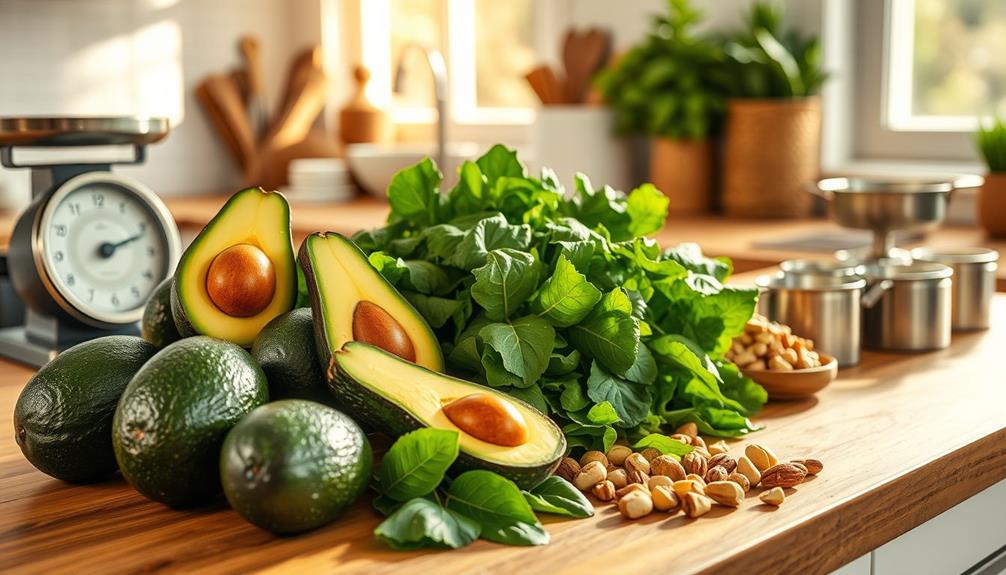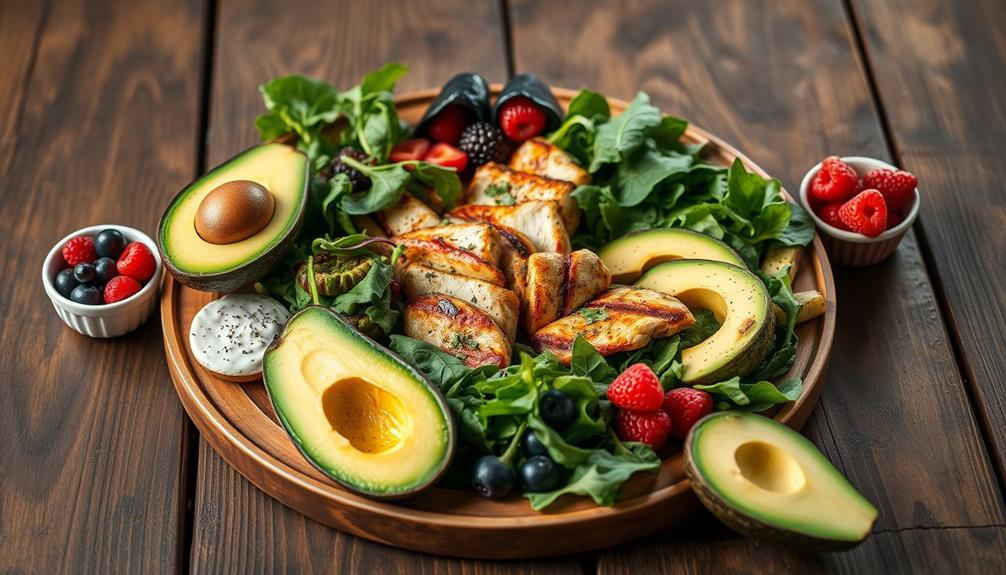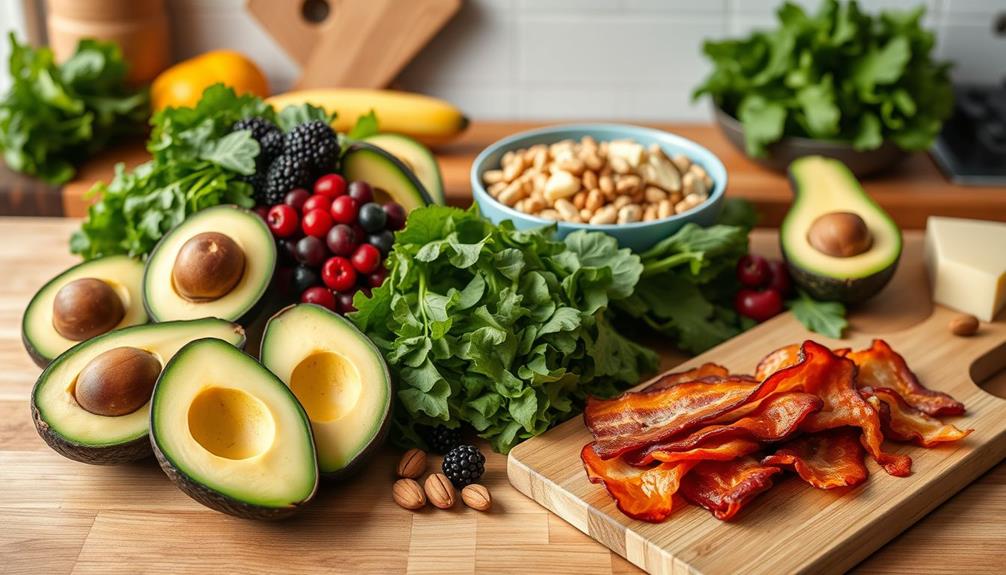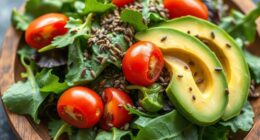To start the keto diet for weight loss, you'll want to drastically cut carbs to about 20-50 grams daily. Focus on high-fat foods like avocados, nuts, and olive oil while including low-carb veggies like leafy greens. Prioritize healthy proteins such as grass-fed meats and eggs. Stay hydrated to avoid "keto flu" symptoms by drinking plenty of water and balancing your electrolytes. Gradually reduce carbs to ease into ketosis and monitor your macronutrient ratios—70% fats, 20% protein, 10% carbs. By following these tips, you'll set yourself up for success and discover even more effective strategies along the way. One effective strategy is to use the keto diet calculation method to track your macronutrient intake and ensure you are staying within the recommended ratios. Additionally, consider incorporating intermittent fasting to enhance the effects of the keto diet and further promote weight loss. Remember to listen to your body and make adjustments as needed to find the perfect balance for your individual needs. With dedication and consistency, you can achieve your weight loss goals on the keto diet.
Key Takeaways
- Begin by reducing carbohydrate intake to 20-50 grams per day to induce ketosis effectively.
- Focus on consuming high-fat foods like avocados, nuts, and olive oil to meet macronutrient ratios.
- Incorporate low-carb vegetables such as leafy greens and broccoli for essential nutrients and fiber.
- Stay hydrated and balance electrolytes by increasing intake of sodium, potassium, and magnesium to mitigate "keto flu" symptoms.
- Gradually reintroduce healthy carbohydrates after the initial phase to maintain weight loss and metabolic health.
Understanding the Keto Diet
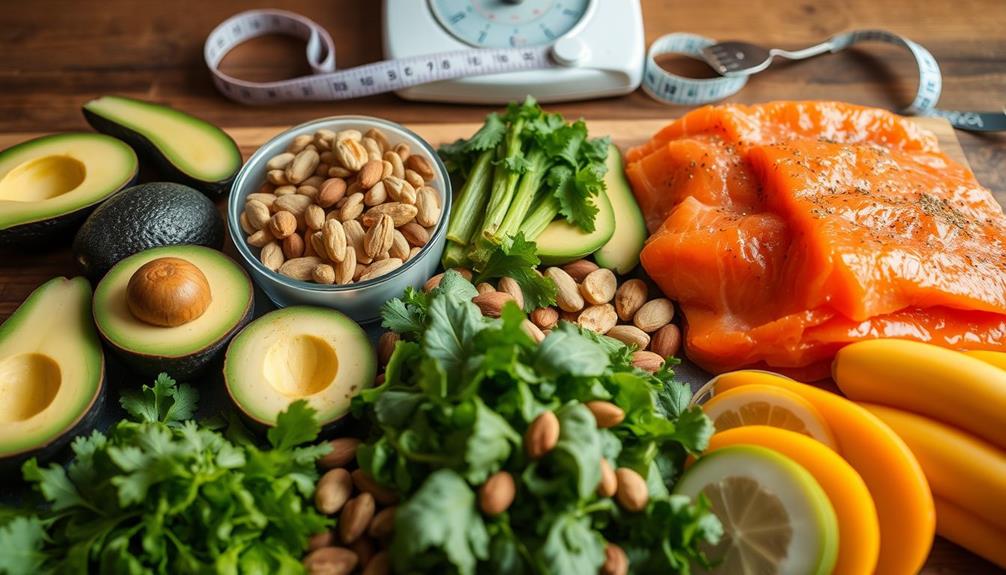
To kick off your journey into the ketogenic diet, it's imperative to grasp what it really involves. The keto diet is a high-fat, low-carb diet designed to shift your body into a metabolic state known as ketosis. In this state, your body burns fat for energy instead of carbohydrates.
To achieve this, you'll need to restrict your carbohydrate intake to about 20-50 grams per day, which is markedly lower than typical dietary recommendations. It's also important to reflect on hydration levels during dietary changes, as juice diets may lead to nutrient deficiencies if not balanced properly.
Understanding macronutrient ratios is essential; generally, you'll aim for approximately 70% of your calories from healthy fats, 20% from protein, and just 10% from carbohydrates. This balance is key for maintaining nutritional ketosis, where your body produces ketones from fat, providing an alternative energy source for your brain.
As you explore the keto diet, focus on incorporating healthy fats while keeping an eye on your carb consumption. This approach not only supports weight loss but also helps with blood sugar control and other health benefits.
Food Choices for Keto
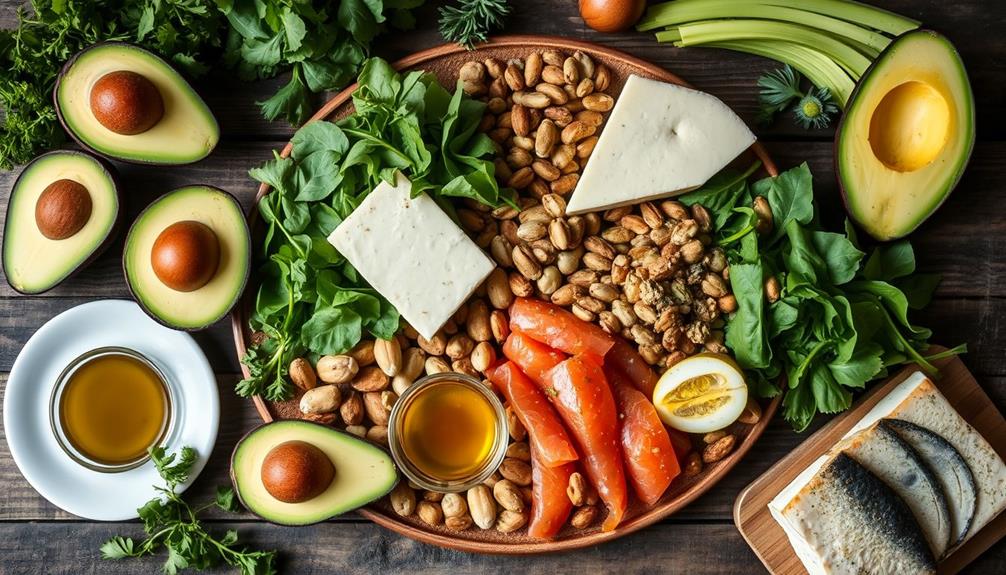
Selecting the right foods is key to successfully following the keto diet. Your food choices can greatly impact your carbohydrate intake and overall weight loss journey. Start by focusing on high-fat foods, which should comprise about 70% of your daily caloric intake.
Incorporating a balanced diet is vital for long-term health benefits and can also help maintain motivation throughout your weight loss journey. Here are three essential food categories to prioritize:
- High-Fat Foods: Incorporate avocados, nuts, seeds, olive oil, and fatty fish. These foods provide healthy fats that support ketosis.
- Low-Carb Vegetables: Choose leafy greens, broccoli, and cauliflower. These options are nutrient-dense and low in carbohydrates, allowing you to stay within your limits without sacrificing health.
- High-Quality Proteins: Select grass-fed meats, eggs, and full-fat dairy. It's important to maintain moderate protein levels to prevent excess glucose production from protein conversion.
Remember to limit your carbohydrate intake to 20-50 grams per day by avoiding sugary foods, grains, and most fruits (except berries).
Read food labels carefully to spot hidden carbs, and prioritize whole foods to align with the ketogenic guidelines. By making these informed food choices, you'll be well on your way to achieving your keto goals.
For more strategies on maintaining a balanced diet, check out effective strategies for weight loss.
Health Benefits of Keto

Wondering how the keto diet can benefit your health? The ketogenic diet is known for its significant weight loss potential, with studies showing you could lose an average of 2 pounds more than those on traditional low-fat diets.
One of the standout health benefits is improved blood sugar control, especially for those with type 2 diabetes, where about 60% of participants have successfully reversed their condition. Additionally, adopting a healthier lifestyle through dietary changes can also help manage conditions like gout nutrition effectively.
As you switch to burning fat for fuel, you might notice increased energy levels and improved mental clarity. This is because ketones serve as a more efficient energy source for your brain.
Additionally, the keto diet shows promise for neurological conditions, helping to reduce seizure frequency in epilepsy patients and possibly slowing tumor growth in specific cancer types.
On the cardiovascular front, the ketogenic diet can enhance HDL cholesterol levels and lower triglycerides, contributing to better overall cardiovascular health.
With all these benefits, it's clear that adopting a keto lifestyle can positively impact not just your weight, but your overall well-being too.
Managing Side Effects

While the health benefits of the keto diet can be impressive, some people encounter side effects during the initial adjustment period. You might experience "keto flu" symptoms like fatigue, headache, and nausea as your body shifts into ketosis.
To support your body during this phase, incorporating practices like yoga for back pain can help alleviate tension and promote relaxation. Thankfully, there are ways to manage these side effects effectively.
- Stay Hydrated: Maintaining proper hydration is essential. Drink plenty of water to support your body's shift and help alleviate symptoms.
- Balance Your Electrolytes: Increased sodium, potassium, and magnesium intake can help counteract the keto flu. Consider adding low-carb vegetables to your meals or using supplements to maintain your electrolyte balance.
- Adjust Your Carbohydrate Intake Gradually: Easing into a lower carbohydrate intake over several days can make the shift smoother and minimize discomfort.
Alongside these strategies, confirm you're getting enough fiber intake from low-carb vegetables to avoid digestive issues like constipation.
Regular physical activity can also enhance your adaptation to ketosis, making the process more comfortable. By addressing these factors, you'll set yourself up for successful weight loss on the keto diet.
Long-term Keto Strategies
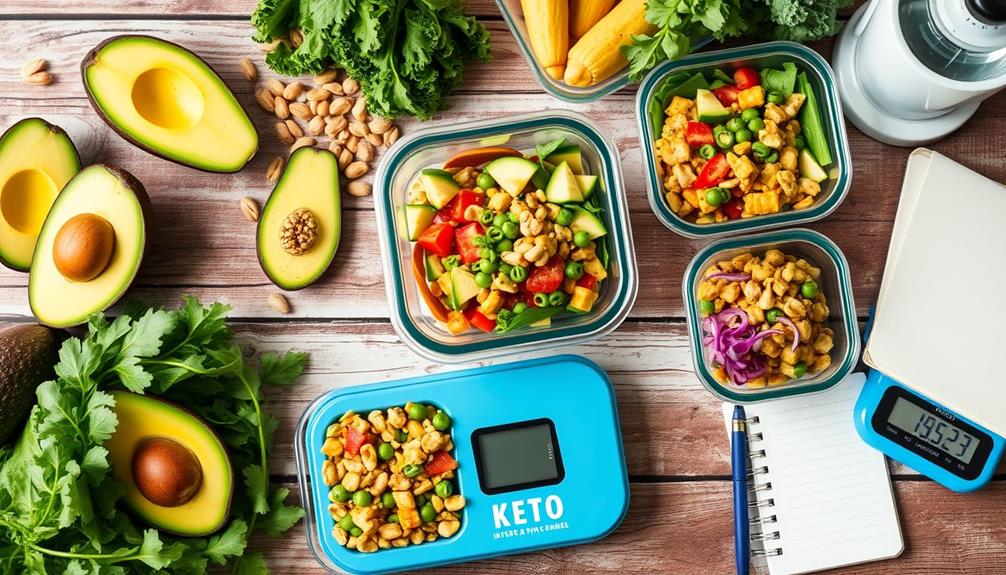
Maintaining long-term success on the keto diet requires a thoughtful approach to your eating habits and lifestyle. To achieve long-term weight loss, it's essential to gradually reintroduce healthy carbohydrates after the initial phase. Focus on nutrient-dense sources to prevent nutrient deficiencies. Regularly monitoring your macronutrient ratios—70% fat, 20% protein, and 10% carbs—ensures you stay in ketosis while adjusting for your unique energy needs.
Here's a quick overview of key strategies:
| Action | Purpose |
|---|---|
| Incorporate low-carb vegetables | Boost nutrient intake |
| Choose quality protein sources | Support muscle maintenance and recovery |
| Engage in regular physical activity | Enhance weight loss and metabolic health |
Transition to a balanced diet post-keto that includes whole foods, while being mindful of carbohydrate intake to prevent weight regain. Embrace a variety of keto-friendly foods to avoid monotony and receive essential vitamins and minerals. By following these strategies, you'll not only maintain your progress but also enjoy a healthier lifestyle that supports your overall well-being.
Frequently Asked Questions
How Do I Start My Keto Diet for the First Time?
To start your keto diet, calculate your macronutrient ratios, stock up on high-fat, low-carb foods, gradually decrease carbs, plan meals, and stay hydrated. This approach helps you shift smoothly into ketosis and reduces potential side effects. As you start your keto journey, it’s important to consult with a healthcare professional or a registered dietitian to ensure that the diet is safe and suitable for your individual needs. Additionally, staying active and incorporating regular exercise can complement your keto diet and help you achieve the best results. By following these guidelines, you can set yourself up for success and embark on the best keto diet for your body. In addition to consulting with a healthcare professional, it’s important to educate yourself on keto diet tips and strategies to ensure you are following the diet correctly. This may include learning about the potential side effects of starting a keto diet, as well as how to track your macronutrient intake and make adjustments as needed. By staying informed and continuously learning about the keto diet, you can make informed choices that support your health and weight loss goals.
How Do I Start Losing Weight on Keto?
To start losing weight on keto, you'll need to lower your carb intake considerably, focus on high-fat foods, stay hydrated, and track your progress. This approach helps your body enter ketosis and burn fat efficiently.
What Are the 9 Rules of Keto?
You'll want to follow these nine rules: limit carbs to 20-50 grams, prioritize healthy fats, moderate protein, stay hydrated, maintain electrolytes, avoid processed foods, focus on whole foods, plan meals, and track your intake.
How Much Weight Can You Lose in a Month on Keto?
Kicking off keto, you might witness a wonderful weight drop—anywhere from 1 to 10 pounds in the first month! The scale's success often depends on your dedication, dietary choices, and individual metabolism.
Conclusion
To sum up, diving into the keto diet could be your golden ticket to weight loss nirvana! Imagine shedding pounds faster than a cheetah on roller skates, all while indulging in delicious fats. With the right food choices and strategies, you'll transform into a lean, mean, fat-burning machine. Sure, there might be a few bumps along the way, but who wouldn't trade a little discomfort for a life of energy and confidence? Embrace the keto journey—your future self will thank you!
